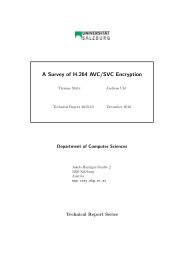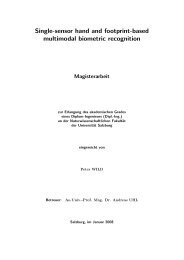Pit Pattern Classification in Colonoscopy using Wavelets - WaveLab
Pit Pattern Classification in Colonoscopy using Wavelets - WaveLab
Pit Pattern Classification in Colonoscopy using Wavelets - WaveLab
You also want an ePaper? Increase the reach of your titles
YUMPU automatically turns print PDFs into web optimized ePapers that Google loves.
2 <strong>Wavelets</strong><br />
Now, that we have def<strong>in</strong>ed the scal<strong>in</strong>g function φ, we can construct a suited wavelet function<br />
ψ m+1,n = √ 1 ∑<br />
b k φ m,2n+k (t) (2.24)<br />
2<br />
k<br />
where<br />
b k = (−1) k c Nk −1−k (2.25)<br />
and N k is the number of scal<strong>in</strong>g coefficients.<br />
Analogous to equation (2.21) we can express b k as<br />
b k = 〈φ(2t − k), ψ(t)〉 (2.26)<br />
From equation (2.24) we can see, that the wavelet function ψ can be expressed <strong>in</strong> terms<br />
of the scal<strong>in</strong>g function φ. This is an important relationship which is used <strong>in</strong> the next section<br />
to obta<strong>in</strong> the filter coefficients.<br />
2.4 Filter based wavelet transform<br />
In signal process<strong>in</strong>g usually a signal is a discrete sequence. To analyze such a signal with<br />
the wavelet transform based on filters so-called filter banks are needed, which guarantee a<br />
perfect reconstruction of the signal. A filter bank consist of a low pass filter and a high<br />
pass filter. While the low pass filter (commonly denoted by h) constructs an approximation<br />
subband for the orig<strong>in</strong>al signal, the high pass filter (commonly denoted by g) constructs a<br />
detail subband consist<strong>in</strong>g of those details, which would get lost if only the approximation<br />
subband would be used for signal reconstruction.<br />
To construct a filter bank we need to compute the coefficients for the low pass filter h first.<br />
However, s<strong>in</strong>ce the scal<strong>in</strong>g equation is used to get the approximation for a signal, h can be<br />
composed by us<strong>in</strong>g the coefficients c k from equation (2.20):<br />
h[k] = c k (2.27)<br />
Now, us<strong>in</strong>g equations (2.24) and (2.25), we are able compute g from h:<br />
g[k] = (−1) k h[N k − 1 − k] (2.28)<br />
For a discrete signal sequence x(t) the decomposition can be expressed <strong>in</strong> terms of a<br />
convolution as<br />
y a (k) = (h ∗ x)[k] (2.29)<br />
12








